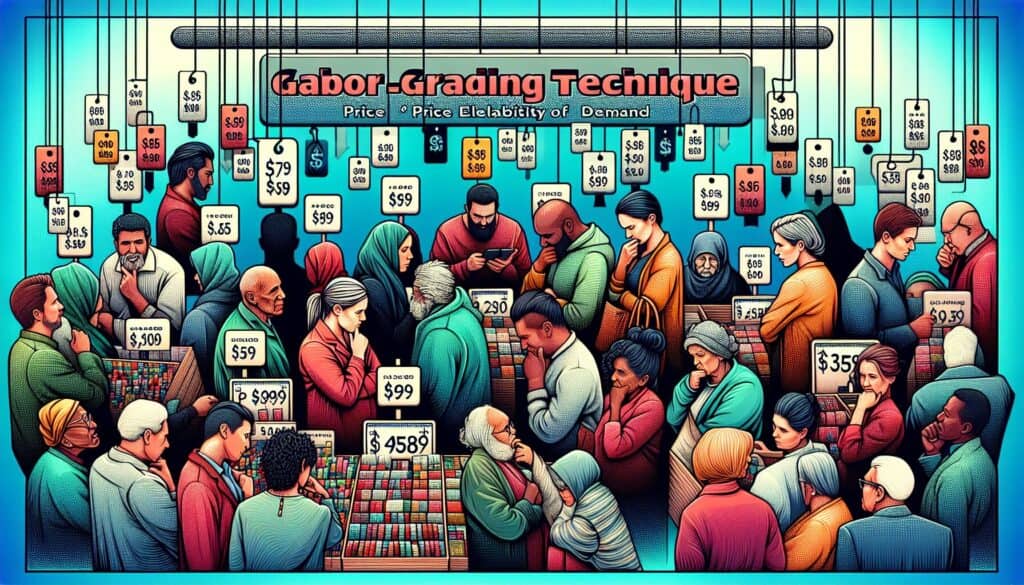Determinare l'elasticità al prezzo della domanda di un prodotto chiedendo ai potenziali clienti la loro probabilità di acquisto a diversi livelli di prezzo.
- Metodologie: Clienti e marketing, Economia, Progettazione del prodotto
Tecnica di determinazione dei prezzi di Gabor-Granger

Tecnica di determinazione dei prezzi di Gabor-Granger
- Esperienza del cliente, Ricerca di mercato, Gestione del prodotto, Prezzi dei prodotti
Obiettivo:
Come si usa:
- Agli intervistati viene mostrato un prodotto e viene chiesto se lo acquisterebbero a un prezzo specifico. In caso di risposta affermativa, il prezzo viene aumentato; in caso di risposta negativa, viene abbassato (oppure viene presentata una serie casuale di prezzi). Questa procedura continua per diversi punti di prezzo per creare una curva di domanda.
Professionisti
- Misura direttamente la disponibilità ad acquistare a prezzi specifici, aiuta a stimare i ricavi e il potenziale di profitto a diversi livelli di prezzo, è relativamente semplice da implementare nelle indagini.
Contro
- L'intento d'acquisto ipotetico può non riflettere il comportamento d'acquisto reale, non tiene conto esplicitamente delle azioni dei concorrenti o delle alternative di prodotto nell'interrogazione.
Categorie:
- Clienti e marketing, Economia
Ideale per:
- Stimare la domanda e i ricavi potenziali di un prodotto a vari punti di prezzo specifici.
The Gabor-Granger Pricing Technique is particularly effective in various stages of product development and marketing strategies across several industries including consumer goods, technology, and pharmaceuticals. This methodology can be especially beneficial during the product ideation and prototype testing phases, where understanding customer sentiment towards pricing can lead to informed design and marketing decisions. Key participants in this technique typically include product managers, market researchers, and pricing strategists, who together analyze customer responses to shape pricing strategies that align with perceived value. For instance, in the technology sector, companies launching new devices can employ this method to gauge how potential customers respond to different price points, allowing them to optimize pricing strategies right before launch. The healthcare industry often employs this technique in market research for new drugs or medical devices, where it is critical to understand pricing dynamics to ensure market access and reimbursement. The simplicity of this method allows organizations to gather quantifiable data efficiently through surveys and online platforms, which can be rapidly analyzed to generate demand curves, thus providing actionable insights that can adapt to different segments and preferences. By incorporating demographic factors or psychographic profiles, firms can segment responses, allowing for targeted pricing strategies that cater specifically to identified consumer bases, enhancing revenue potential while also refining product offerings based on real market data. This adaptability makes the Gabor-Granger approach a versatile tool for organizations navigating multiple market uncertainties.
Fasi chiave di questa metodologia
- Show respondents a product along with an initial price point.
- Ask respondents if they would purchase the product at that price.
- If yes, increase the price in the next iteration; if no, decrease the price.
- Repeat this process for a series of price points to map demand.
- Analyze the responses to construct a demand curve based on willingness to buy.
Suggerimenti per i professionisti
- Conduct sensitivity analysis to understand how variations in pricing affect demand elasticity, refining your price ranges accordingly.
- Incorporate psychographic factors into your survey design to capture deeper motivations and psychological pricing thresholds of different segments.
- Iterate on the pricing experiments by utilizing A/B testing methodologies to identify the most effective price points in real-time settings.
Leggere e confrontare diverse metodologie, raccomandiamo il
> Ampio archivio di metodologie <
insieme ad altre 400 metodologie.
I vostri commenti su questa metodologia o ulteriori informazioni sono benvenuti su sezione commenti qui sotto ↓ , così come tutte le idee o i link relativi all'ingegneria.
Contesto storico
1960
1980
1983
1990
1995
2000
2010
1950
1980
1980
1986
1994
1995
2000
(se la data non è nota o non è rilevante, ad esempio "meccanica dei fluidi", viene fornita una stima approssimativa della sua notevole comparsa)














Post correlati
Gestione delle operazioni di produzione (MOM)
Sistema di esecuzione della produzione (MES)
Piano di controllo della produzione
Test manuali
Schede di valutazione della movimentazione manuale (MAC)
ManTRA (Strumento di valutazione dei rischi delle attività manuali)